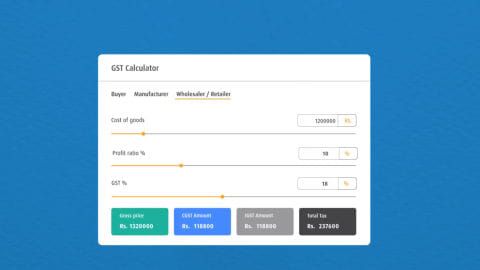Basics of GSTR 1
To comply with GST requirements, all those under the GST regime must file GST returns. These returns specify income details for clarity and calculate the amount of tax you are required to pay to the government. It is important to remember that you will need GST-compliant invoices for sales and purchases if you wish to file GST returns. When it comes to filing your taxes, GSTR 1 is one of the necessary forms. It's because the information you file under GSTR 1 is used as a base for all other forms to be auto-populated. To understand this better and comply with GST norms, read on for more information on GSTR 1.
What is GSTR 1?
GSTR 1 is a form that accounts for the outward supply of goods. It is a monthly or sometimes quarterly return that you have to file to account for your business. It means any individual involved in the supply of goods needs to specify the supply and recipient details. By doing so, the returns for the inward supply will be auto-populated with the details filed in GSTR 1. Since GSTR 1 is the foundation that affects other GST forms, you must fill it with utmost care.
Who is liable to file GSTR 1?
Every registered dealer is liable to file GSTR 1. It is mandatory irrespective of the transactions and sales for a particular month, which means that even if there are no sales or transactions, you, as a registered dealer, have to file GSTR 1. However, the below individuals/entities are exempt from filing GSTR 1:
- An input service distributor (ISD): If your business receives invoices for services used by your branches, you fall in the category of an input service distributor under GST
- Composition dealer: You are a composition dealer, if you have registered your business under the composition scheme of GST. From 1st April 2019, companies with an annual turnover of up to Rs. 1.5 crore can opt for the composition scheme
- A supplier of online information, database access or retrieval services
- Non-resident taxable person: You fall under the category of a non-taxable resident person, if you import goods and services from outside India or are in charge of managing a business on behalf of a non-resident Indian (NRI)
- A taxpayer is liable for collecting tax at source (TCS), or a taxpayer is responsible for deducting tax at source (TDS).
How to file GSTR 1?
Here are the steps you need to follow to file GSTR 1
- Use the provided user ID and password to log in to the GSTN portal
- Look for ‘services’
- Click on ‘returns’
- Select the month and year for which you would like to file for on the ‘returns dashboard’
- Once the returns for the specified period are displayed, click on ‘GSTR 1’
- You can then prepare the returns online or upload the returns
- You can choose to add invoices or upload the invoices
- Double check the form to ensure it is filled correctly with accurate details
- Click on ‘submit’
- Once the entered information gets validated, click on ‘file GSTR 1’
- Digitally sign the form or E-sign it
- Click on ‘yes’ once a pop-up is displayed on your screen to confirm your decision to file GSTR 1
- Wait for an acknowledgement reference number (ARN) to be generated
Filling the GSTR 1 form: Explained
GSTR 1 has 13 different sections that need to be filled out by you. However, a few of these may be auto-populated. Let's take a look at the 13 various fields below.
- An auto-populated result for the GSTIN of the person filing the return
- An auto-populated result of the name of the person filing the return
- The total turnover of the previous financial year needs to be filled once, and then will automatically auto-populate the form with the closing balance henceforth
- Details of the outward supplies to a registered person that is taxable
- Details of the outward supplies (inter-state) to an end consumer where the transaction exceeds Rs. 2.5 lakh
- Zero-rated supplies as well as deemed exports (to EOUs and SEZs) along with details of invoice, shipping bill or bill of export
- A total consolidation of all outward supplies for the month, including through e-commerce operators and up to Rs. 2.5 lakh
- Details of exempted, non-GST, and nil supplies if they aren’t already mentioned
- Any revisions/amendments that need to be made towards the outward supplies of previous tax periods, including debit/credit notes and refund vouchers
- Details of outward supplies listed on the basis of HSN codes
- Any tax due to advance payment received
- Any taxes paid for the previous periods or reporting periods
- Documents issued during the period for which GSTR 1 is being filed including invoices, revised invoices, credit notes and debit notes
What do you need to file GSTR 1?
You need to have the below documents and information ready with you, in order to file GSTR 1.
- A valid and genuine goods and services tax identification number (GSTIN)
- The user ID and password to sign into the portal
- A valid digital signature certificate (DSC) unless you can e-sign the form as per your categorisation as a supplier
- Aadhaar number if you are going to e-sign the form
- Access to the mobile number mentioned on your Aadhaar card
What are the late fees that can be incurred on GSTR 1?
It is important to remember that GSTR 1 also has a due date by which it needs to be filed, like all other tax filing forms. To meet this GSTR 1 due date and avoid late fees, you will need to file GSTR 1 by the 10th of the following month. It means that you will need to file returns for January by 10th February and so on. However, this is only in terms of businesses with more than Rs. 1.5 crore turnover. If you have a turnover less than this, you will need to file GSTR 1 quarterly by the last day in that particular period.
If you do not submit GSTR 1 before the GSTR 1 filing date, you will need to pay the penalty for failing to comply with these rules. These late fees are Rs. 50 or Rs. 20 per day. The latter is applicable if you have nil returns to file and delay submitting GSTR 1. Recently, for the period July 2017 to September 2018, the government has waived this fee entirely. If you have paid it, the sum will be refunded to your electronic cash ledger for future use.
Filing GSTR 1: What you do need to keep in mind?
Filing returns for your business can sometimes be a little tricky. However, if you are careful, you need not worry about confusion or mistakes. So, take a look at a few pointers to keep in mind while filing GSTR 1.
- Ensure you have entered the correct GSTIN code and HSN codes to avoid any discrepancies
- Confirm whether the transaction falls under the intra-state or inter-state category
- You can change uploaded bills multiple times; however, you will not be able to change an invoice once the return has been submitted
- You cannot revise the return once you have submitted the same and need to make any corrections in the next month’s GSTR 1
- GSTR 1 is part of GST registration and GST return filing and you do not have to pay any taxes until the filing of GSTR-3B
- Upload invoices at various intervals during the month to avoid bulk uploads
- Companies like LLPs (Limited Liability Partnerships) and FLLPs (Foreign Limited Liability Partnerships) are obligated to provide a digital signature certificate (DSC)
- Suppliers such as proprietors, partnership concerns, HUFs, and others can E-sign the GSTR 1
- If the point of supply has changed and is now in a different state, the SGST charged will be as per the new state
- Once a recipient has accepted the details in the GSTR 1, you cannot make any changes to the tax invoice. However, you can issue a credit note or a supplementary invoice to make room for the changes
- File GSTR 1 easily by using third-party software
While you may already know simple procedures such as calculate GST, now you’re sure to have a better understanding of the finer aspects of GSTR 1. Knowing this information regarding GSTR 1 means that you will be able to comply with GST requirements more effortlessly and learn how to use the system to your advantage as well!
Additional reads on GST:
DISCLAIMER:
While care is taken to update the information, products, and services included in or available on our website and related platforms/websites, there may be inadvertent inaccuracies or typographical errors or delays in updating the information. The material contained in this site, and on associated web pages, is for reference and general information purpose and the details mentioned in the respective product/service document shall prevail in case of any inconsistency. Subscribers and users should seek professional advice before acting on the basis of the information contained herein. Please take an informed decision with respect to any product or service after going through the relevant product/service document and applicable terms and conditions. In case any inconsistencies observed, please click on reach us.
*Terms and conditions apply








